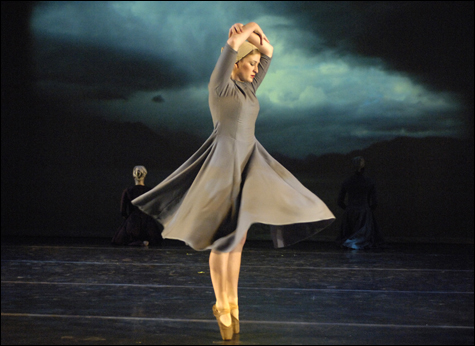
DARK ELEGIES: A community gathering that encompasses both individual grief and ritual folk
dances. |
The great choreographers Antony Tudor and José Limón were no strangers to young dancers. Both of them taught and choreographed for their students at the Juilliard School. Limón’s modern-dance company was based at Juilliard, and that created close links between students and his ensemble of professionals. Tudor’s Juilliard choreography was often performed by professional ballet companies. Boston Conservatory director of dance Yasuko Tokunaga studied with both masters at Juilliard, and last weekend the Conservatory honored their centennial birthdays with a program of small and large works.
In 1970, Antony Tudor (April 4, 1908–April 19, 1987) received a National Endowment for the Arts grant to make three works for Juilliard students that would serve later as repertory pieces for small ballet companies. This was an example of the imaginative thinking at the NEA in its early days: grassroots funding of creative artists would pay off by enriching the performance mainstream. Several companies did perform Continuo, among them Boston Ballet II, in 1986.
Continuo had a private showing at Juilliard in 1971 and was premiered officially on May 17, 1976, by Syracuse Ballet Theater. Tudor set the dance, in essence a study, for three couples to Johann Pachelbel’s Canon in D, countering the music’s overfamiliarity with an arrangement for string quartet. In its seven-minute duration, Continuo works like a pocket exposition of classical ballet steps, partnering, and compositional variety.
The music is so transparent and the dance materials are so sparing that the piece’s syntactical originality is clear. It even winds up with a pun on a ballet cliché. The men kneel with one leg off the floor in arabesque and the women stand behind them, both supporting them and being supported.
Tudor made Little Improvisations (1953) during a summer teaching job at Jacob’s Pillow; it was staged nine years later at Juilliard. Set, rather obviously, to most of Robert Schumann’s Kinderszenen (“Scenes from Childhood”), this duet has a lot of charm, and it asks the dancers for technical subtlety as well as playfulness.
Tudor’s fusion of step invention, musical responsiveness, and character was unique in 20th-century ballet. He’s pegged as a great dramatist for his theater ballets (Jardin aux Lilas, Pillar of Fire), but the small works, and especially Dark Elegies, reveal the way he could infuse classical technique with expressive power.
Created in 1937 for the Ballet Rambert in London, Dark Elegies is a singular work, even for Tudor. He constructed the poignance of Mahler’s Kindertotenlieder (“Songs on the Death of Children”) in a community gathering that encompasses both individual grief and ritual folk dances. The Conservatory dancers showed fine technical abilities here, as they did throughout the evening, but I felt only Astrid Segredo in the fourth lament summoned an intensity equal to the theme. David Kravitz was the wonderful guest baritone, and the orchestra was led by Beatrice Jona Affron.
No choreographer has crafted the classical vocabulary as a conveyor of feelings better than Tudor. The modern dancers, his contemporaries, opened up movement expressivity even farther by relinquishing the ballet language.
José Limón (January 12, 1908–December 2, 1972) was at the peak of his career in 1958 when he made Missa Brevis, in tribute to the courage and faith of Europeans recovering from World War II. To Zoltan Kodály’s Missa in tempore belli, he set a large ensemble of Juilliard students, augmented by Limón company dancers, against a lone male figure, a leader who struggles with doubt.
The dance is large and sweeping, the music (by an unnamed recorded chorus and organist) majestic. Missa Brevis makes an apt companion piece to Dark Elegies. Tudor depicts a community of close friends taking solace in formality. Limón creates a congregation of 21 souls, refugees perhaps, lost except for the temporary refuge of the Sacrament. They rush from place to place, huddling together, then scattering. They cry out, sink into uncertainty. Their leader stands aside. The best he can offer is strength — but not conviction.